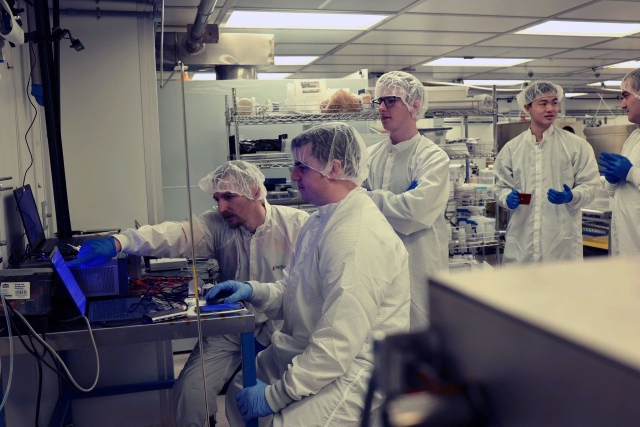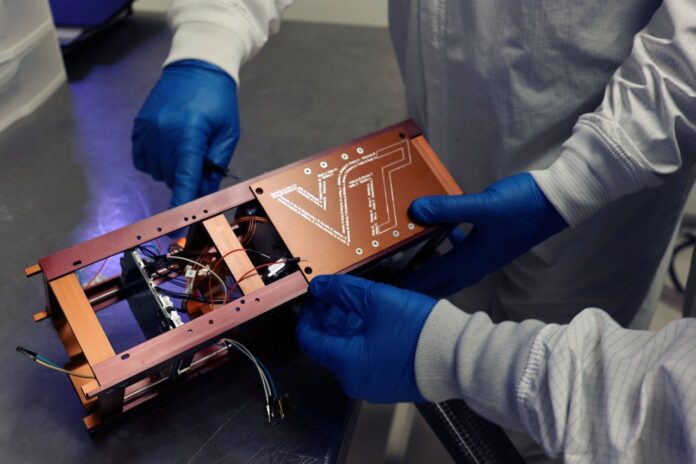A team of Virginia Tech researchers and students is preparing to deliver a 3U CubeSat for space launch qualification testing. The satellite, once cleared for flight, is scheduled to launch on Northrop Grumman’s Cygnus NG-19 spacecraft from Wallops Island, Virginia, later this year.
This flight – designed, built, and operated by students – represents the next generation of the ThickSat launched in February 2021, incorporating lessons learned and upgrading specific deployable structures and materials technologies.
Dubbed the Ut ProSat-1, this mission provides both undergraduate and graduate students an opportunity to design, fabricate, assemble, and validate a 3U satellite that will serve as a testbed for NASA Langley Research Center’s ultralightweight deployable boom technology. Throughout the deployment, the students will communicate and operate the mission through Virginia Tech’s Ground Station, execute a number of autonomous/remote deployments of the boom, and recover inertial measurement units and collect data from in-space deployment.
Come sail away — with solar sails
NASA’s new deployable structures and materials technologies in development will benefit solar sail propulsion systems destined for future low-cost deep space missions. Just as a sailboat is powered by wind in a sail, solar sails employ the pressure of sunlight for propulsion, eliminating the need for conventional rocket propellant.
These novel, lightweight booms are being tested on a small scale through deployment from CubeSats. The composite booms are made from a polymer material that is flexible and reinforced with carbon fiber.
This mission is made possible through a partnership between NASA Langley Research Center, the Virginia Institute for Spaceflight and Autonomy, and the Virginia Commercial Space Flight Authority, also known as Virginia Space. Two slots were secured on the Cygnus NG-19 spacecraft, reserved for educational payloads from both Virginia Tech and Old Dominion University. The student-built 3U units will test NASA’s carbon fiber technology in different capacities.
“The boom Virginia Tech will be flying is unique in its inclusion of copper traces down the entire length, making it possible to power, control, and receive data from a sensor at the boom tip,” said Jonathan Black, professor in the Kevin T. Crofton Department of Aerospace and Ocean Engineering. “Data obtained from a variety of experiments will guide the design of future larger-scale composite solar sail systems to be used for space weather early warning satellites, near-Earth asteroid reconnaissance missions, or communications relays for crewed exploration missions.”
Virginia Tech’s most recent space experiment was a 6T ThickSat, designed to passively deploy a much smaller boom arm once. Building off this experience and the lessons learned throughout the ThickSat flight, the new mission provides opportunities for additional experimentation, repeated flights, and testing new capabilities.
To support the larger payload and free-flying spacecraft, the avionics system for the Ut ProSat-1 – which includes power, battery, radio, and communications units – was built in-house by the Virginia Tech team. This year, the mission will contain three payloads, with the primary one being the boom deployer. The team will evaluate the deployer’s reliability by testing the deployment of the arm multiple times and aim to capture accelerometer data from the tip of the boom.
To measure the reliability of the deployer, a visible light camera will capture an image of the boom when fully deployed for ground confirmation and an infrared camera will record temperature measurements of the boom as it is deployed and retracted. Additionally, an encoder keeps track of the angular position of the spool and an inertial measurement unit records acceleration at the tip of the boom.
The mission is expected to last approximately 10 days, depending on exact orbital configurations. If successful, the mission will give insight into the viability of designs for future missions with novel deployable structures.
Extreme constraints in space
“Some of the most complex engineering projects we tackle are those in space,” said Gustavo Gargioni, a fifth-year Ph.D. candidate studying aerospace engineering and currently serving as Ut ProSat-1 project manager. “Building a spacecraft really pushes you to the limit because the constraints are so small. Each component and sub-system needs to work together and must be extremely optimized, use minimal power, and capture only the most essential data. We take the conditions we have for experimentation on Earth for granted. In space, we are working on an extremely small scale, but there is beauty in leaning into those constraints.”

For more than 40 undergraduate and graduate students, the Ut ProSat-1 project provides an invaluable opportunity to plan and fly a successful mission. Since April 2021, sub-teams have been working on avionics, integration, mechanical and electrical payload, and testing.
“While their work in the classroom offers some crossover into additional engineering disciplines, a student project of this magnitude offers groups of engineers the opportunity to learn from one another and come out stronger working in multiple disciplines outside of their plan of study,” said Black.
The team has been testing several components in a low-pressure and microgravity environment in a series of high altitude balloon launches at Kentland Experimental Aerial Systems Laboratory. In November, their balloon reached 100,377 feet and enabled testing of the deployer, the payload control module, and multiple sensors.
The completed Ut ProSat-1 is scheduled to be delivered to Wallops Space Flight Facility later this month for space launch qualification testing, and then will be incorporated onto the Cygnus NG-19 spacecraft.
Looking ahead to the launch, the team has defined its criteria for measuring a successful mission. According to Gargioni, key successes will include establishing uplink/downlink communication with the Virginia Tech Ground Station, commissioning the spacecraft into science mode, and confirming deployment through the decoder and multiple camera images.

“For us as students, the experience gained in flying a successful mission is immeasurable,” said Gargioni. “But another major gain for our program is the development of an infrastructure for operations, easing transition from one project to another. Experienced students eventually become leaders of sub-teams, sharing their knowledge and setting the next group up for success.”
The Ut ProSat-1 mission was guided by faculty advisors Black and Professor Kevin Shinpaugh and research associates Sheyda Davaria, Samantha Parry-Kenyon, and Zach Leffke. Additional support came from the Center for Space Science and Engineering, also known as Space@VT, as well as departmental laboratories in aerospace and ocean engineering and electrical and computer engineering, the Puri Satellite Ground Network, and the Virginia Space Grant Consortium. Team leads and members include undergraduate and graduate students of all skill levels from across the College of Engineering, as well as some majoring in physics.
- Suzanne Miller

